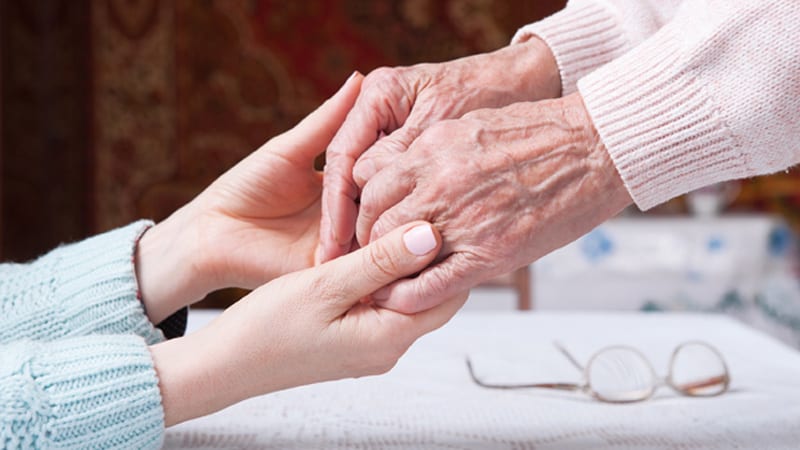'If Only' Moments
Writer Terri L. Jones looks back on providing care for her mother

Terri L. Jones is a professional writer and … a part-time caregiver for her mom, Pat.
WHAT WORKED: Asking lots of questions, taking Mom home on hospice care but not telling her.
WHAT I’D DO DIFFERENTLY: Work harder to avoid her going on a ventilator, get physicians’ input on everything.
THE UNEXPECTED SILVER LINING: “My mother realizes that she was spared for a reason and she’s working hard to make her second chance count.”
A TEACHABLE INCIDENT
The phone rings at 1:30 a.m. It’s Martha, my mother’s partner of 30 years, calling to tell me Mom, who suffers from COPD (chronic obstructive pulmonary disease), is in respiratory failure. The ER doctors have tried a BiPAP machine, a noninvasive way to force air in and out of her lungs. But she’s refusing to keep the mask on. After repeated tries, they’ve resorted to a ventilator.
From that point on, things happen so quickly and the situation is so emotionally charged that Martha, my sister, Patti, and I don’t have a lot of time to contemplate our actions.
But looking back nine months later, we know that we did a lot of things right – but maybe just as many wrong. We realize that things could’ve ended so much differently.
THE ‘IF ONLY’ MOMENTS
The first – and perhaps most pivotal – “if only” moment is my sister’s. Patti, who is an occupational therapist, had talked earlier to Mom about the possibility of being on a ventilator – but she wishes she had stressed how hard she should work to avoid it. While ventilators can save a person’s life, they can also make it so hard to regain quality of life.
For five days, while Mom lies sedated, her body weakens to the point that she can no longer move her arms or legs. But thankfully, during the fifth day’s breathing trial, the respiratory therapist is able to get Mom to breathe on her own, and the tube is removed from her throat. The joy in the room is palpable!
But by 10 p.m., she’s in respiratory distress again. We try the BiPAP and this time she keeps the mask on. But a blood gas test shows that she’s still retaining too much carbon dioxide (which put her in respiratory failure to begin with). The nurse pulls me aside. If we’ve ruled out the ventilator (which we have), she explains, “There’s nothing more we can do.”
It’s late and there are no doctors around. Looking back, I’m not sure why we didn’t ask for one to be called. It’s another “if only.” Instead, we listen to the nurse and decide to let Mom go. The rest of the night is spent watching her receive more and more morphine and agonizingly watching her respirations drop.
Surprisingly, though, Mom’s heart rate and blood pressure remain stable through it all. Come sunrise, she’s still holding her own.
SOME GOOD LUCK – AND GOOD DECISIONS
The intern and respiratory therapist on duty in the morning sing a dramatically different tune from last night’s nurse. When the pulmonologist does rounds, we pepper him with questions. He recommends letting the morphine wear off and doing another blood gas test, then maybe trying the BiPAP again. The three of us agree Mom wouldn’t want to be re-intubated. But there’s no consensus on whether she would be willing to use the BiPAP long-term.
Happily, when Mom emerges from the drugs, her breathing is pretty regular and a blood gas test shows the BiPAP isn’t needed. But the doctor explains that COPD patients will go through many “episodes” in the course of their illness with one being too significant to come back from. “I would give her days or weeks, not months,” he says.
Looking back, I realize we should’ve taken our mother’s strong will into consideration.
We take Mom home on hospice care. Martha says that was “the scariest thing” she’s ever done because she’s always equated hospice with death. For that reason, we decide not to use the word around Mom – probably the smartest move we could’ve made.
The first few days are filled with small steps like Mom is getting movement back in her limbs, eating solid foods and talking. After a few weeks, she’s improved enough to be discharged from hospice, which we didn’t even know was possible. With therapists now coming to the house, Mom’s steps turn into leaps: standing, dressing herself and walking down steps.
A HAPPY ENDING – AND LESSONS LEARNED
Through a glorious mix of bad decisions and good, love and prayers from family, friends and even strangers, and a whole lot of hard work, our story has a happy ending. After nine months (note “months,” not days or weeks), Mom is back to her old self, except for the oxygen tank that she uses at night. However, we realize not everyone is so lucky.
The best advice I can offer is don’t take the medical professionals’ word without question. Ask “why?” and “how?” and even “what else can we do?”
Then, armed with this knowledge, make the best decisions you can. And try not to second-guess yourself. That’s the best you do for someone you love!
Terri L. Jones is a local freelance writer and frequent contributor to BOOMER.


